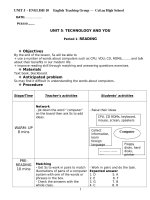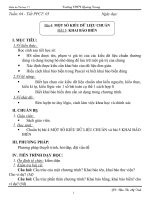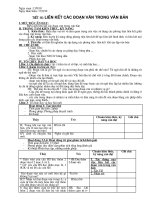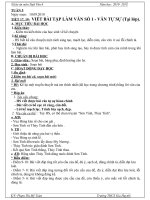5 10 hard times (Scott Foresman)
Bạn đang xem bản rút gọn của tài liệu. Xem và tải ngay bản đầy đủ của tài liệu tại đây (3.71 MB, 10 trang )
Fascinating Facts
•
After Roosevelt’s election, Charles Edison, president of
Thomas A. Edison, Inc., posted this notice: “President
Roosevelt has done his part; now you do something. . . .
It doesn’t matter what you do—but get going and keep
going. This old world is starting to move.”
•
During his first one hundred days in office, Roosevelt
introduced fifteen major laws, gave fifteen messages
to Congress, and held press conferences and cabinet
meetings twice a week.
•
More than 2 million young men worked in the Civilian
Conservation Corps. More than 100,000 of the men
learned to read and write.
Genre
Nonfiction
Comprehension Skill
Summarize
Text Features
• Captions
• Glossary
Scott Foresman Social Studies
ISBN 0-328-14906-3
ì<(sk$m)=bejagd< +^-Ä-U-Ä-U
by Scott Gillam
In this book you will read about a period of
United States history called the Great Depression.
This period began in October 1929 and ended in
December 1941. It had a great impact on people at
the time, and its effects are still felt today.
Vocabulary
stock market
Write to It!
Take the part of a newspaper reporter during
the Depression. Write a two-paragraph article
describing what caused the Depression and how
people reacted to it.
crash
unemployment
Write your article on a separate sheet of paper.
depression
migrant worker
Photographs
Every effort has been made to secure permission and provide appropriate credit for photographic material. The publisher deeply
regrets any omission and pledges to correct errors called to its attention in subsequent editions.
by Scott Gillam
Unless otherwise acknowledged, all photographs are the property of Scott Foresman, a division of Pearson Education.
Photo locators denoted as follows: Top (T), Center (C), Bottom (B), Left (L), Right (R) Background (Bkgd)
ISBN: 0-328-14906-3
Copyright © Pearson Education, Inc.
All Rights Reserved. Printed in the United States of America. This publication is protected
by Copyright, and permission should be obtained from the publisher prior to any prohibited
reproduction, storage in a retrieval system, or transmission in any form by any means,
electronic, mechanical, photocopying, recording, or likewise. For information regarding
permission(s), write to: Permissions Department, Scott Foresman, 1900 East Lake Avenue,
Glenview, Illinois 60025.
1 2 3 4 5 6 7 8 9 10 V0G1 14 13 12 11 10 09 08 07 06 05
Opener: Corbis
2 ©Bettmann/Corbis
4 ©Library of Congress/Bridgeman Art Library
6 ©Getty Images
9 ©Corbis
Editorial Offices: Glenview, Illinois • Parsippany, New Jersey • New York, New York
10 ©Bettmann/ Corbis
11 ©Corbis
Sales Offices: Needham, Massachusetts • Duluth, Georgia • Glenview, Illinois
12 ©Corbis
Coppell, Texas • Sacramento, California • Mesa, Arizona
13 ©Corbis
14 ©Underwood & Underwood/Corbis
Times Get Tough
In the 1920s many people had invested their money in
the stock market. The stock market is where stocks, or
money invested in companies, are traded. The prices of
stocks, however, sometimes rose higher than the stocks’ real
value. This inflation was partly caused by people borrowing
money to buy the stocks. When too many people tried to
make money by selling their stocks, the prices fell sharply
and quickly. A stock market crash was the result. A crash is
a sudden and severe decline in business. In this stock market
crash, some people lost large amounts of money overnight.
Many people, especially the poor, suffered greatly. Food,
clothing, and good housing were hard to find without
money.
By 1932 the rate of unemployment was still growing.
One out of every four people did not have a job. With so
many people out of work, stores closed because no one
had money to spend. Many people did not have enough to
eat or lived in poor housing. Nearly one out of every five
farmers had to sell their farms. Many of these farmers lost
their homes and moved to areas where they could find a
job. A period of severe decline in an economy is called a
depression. From October 1929 until December 1941,
the United States went through a period known as the Great
Depression.
Many people lost large amounts of money
in the stock market crash of 1929.
2
During the early years of the Depression, people who lost their
jobs and had no money depended on private charity for help.
Before the Depression
Herbert Hoover
During the 1920s thousands of small companies were
taken over by larger companies. Membership in labor unions
fell sharply. By 1929 two hundred corporations controlled
more than half of America’s industries. An average of six
hundred banks failed, or went broke, every year. By 1929,
75 percent of all families made less than $3,000 a year.
President Herbert Hoover, who was elected in 1928, tried
to reverse the stock market crash. He asked businesses to
put more money into the economy. But this did not work.
Between 1929 and 1932, investments in business fell by
98 percent, many banks went broke, and more people lost
their jobs and homes. To make things worse, there were
no government programs to provide aid. People who had
lost their homes often gathered in temporary towns called
“Hoovervilles.”
4
5
During the Depression
The Problems of the Farmer
In 1933, the worst year of the Depression, many
Americans lost their jobs. Because they had no other sources
of income, many people sold their cars or homes to raise
money. Others moved in with family members. People who
had lost their homes sometimes moved, looking for a job
anywhere they could find them.
In addition to the problems faced by many people during
the Depression, farmers had more challenges. Many farms
were suffering from drought. Also, many farmers had
borrowed money to buy more land and farm machinery
during the early 1920s to take advantage of high food
prices. When the high prices fell, the farmers still had to pay
interest, or additional money, on their loans. Small farmers
who rented land lost business to farmers who had machines.
It was cheaper for large landowners to farm all the land
themselves. Thousands of people moved west, where they
hoped to find work as migrant workers. These workers
traveled from one area to another in search of work on
farms.
Many farmers who lost their farms
during the Depression traveled west
to California in search of jobs.
6
7
The New Deal
Franklin Delano Roosevelt defeated Herbert Hoover and
became President in 1933. Hoover had asked businesses
to fight the Depression on their own. Roosevelt, however,
believed that the government should help. With new
government programs, called the New Deal, Roosevelt tried
to improve the economy.
Some programs aimed at reforming, or improving
banks and the stock market. The Securities and Exchange
Commission is a government agency that checks to see that
trading in the stock market is done in a fair manner. The
Federal Deposit Insurance Corporation insures peoples’ bank
savings in case of any loss. Both programs were created by
the New Deal and still exist today.
Among the New Deal programs that did not succeed
were the Civil Works Administration, which created
temporary jobs repairing the nation’s roads and bridges.
Another program that failed was the National Recovery
Administration, which made rules for businesses to follow
and included a minimum wage. The Supreme Court found
that the agency took over some of Congress’s powers.
Franklin Delano Roosevelt became President in 1933.
8
9
Fighting the Depression
Roosevelt’s first term as President was successful. Banks
reopened, more people had jobs, and more goods and
services were being produced. As a result, Roosevelt was
elected again in 1936. Some of Roosevelt’s success came
from his wife, Eleanor. She visited New Deal projects across
the country, building public support for them. She took a
special interest in the problems of the poor.
Roosevelt gave informal talks, called “fireside chats,”
over the radio to explain his programs and plans. Together,
Franklin and Eleanor Roosevelt helped to bring the nation
through a difficult time. Despite their efforts, however, the
economy was still weak.
Roosevelt’s “fireside
chats” made Americans
feel as if he were talking
directly to them.
Roosevelt was widely criticized for supporting labor
unions. Labor unions had used the sit-down strike, in which
workers stay inside a factory and refuse to work in order to
get higher pay. Many people also did not like Roosevelt’s
attempt to enlarge the Supreme Court to make it support
his views. When the United States entered World War II
in 1941, increased spending finally ended the twelve-year
Depression.
11
Events around the world during the 1930s were not
peaceful. Japan’s invasion of China and Germany’s attacks
in Europe helped Roosevelt get congressional approval to
increase the national defense. After Germany defeated
France in 1940, Congress passed the draft law. As the
nation got ready to fight a new enemy, the number of
people without jobs decreased by half. Men were called up
to serve in the armed forces. Their places in the workforce
were filled for the first time by women in large numbers.
The economy was growing again, but the nation was also
getting ready for war.
People lined up to see the movies during the Depression.
In the late 1930s, as the United States prepared for war,
many Americans got jobs building ships and airplanes.
America During the 1930s
Movies were the most popular kind of entertainment
during the Depression. Many people went to the movies
once a week. Movies revealed what people were thinking
about as the Depression developed. Some movies reflected
the stock market boom of the 1920s and the resulting crash
of 1929. Musicals, however, revealed people’s need to
believe that better times were on the way.
12
Today’s New Deal Programs
People disagree about how successful the New Deal was
in fighting the Depression. But most agree that life today is
very different because of changes made by the New Deal
in the 1930s. Many programs that were started during the
Depression are still around today. These federal programs
would probably not exist if it had not been for the New
Deal.
How the Depression Still
Affects America
In addition to the New Deal programs, we still feel
other effects of the Great Depression. During Roosevelt’s
presidency, the size and power of the government increased
greatly. Once the economy began to improve, however,
some businesses did not want the programs to continue.
Today, people still disagree about how much power the
government should have over the nation’s economy.
The Wilson Dam in Alabama was created by the Tennessee
Valley Authority.
14
15
In this book you will read about a period of
United States history called the Great Depression.
This period began in October 1929 and ended in
December 1941. It had a great impact on people at
Glossary
the time, and its effects are still felt today.
crash a sudden and severe decline in business
depression a period of severe decline in an economy
Vocabulary
migrant worker a worker who travels from one place
stock market
to another in search of work
crash
stock market an organized market where stocks are
bought and sold unemployment
depression
unemployment the number of workers who are
migrant worker
without jobs
Write to It!
Take the part of a newspaper reporter during
the Depression. Write a two-paragraph article
describing what caused the Depression and how
people reacted to it.
Write your article on a separate sheet of paper.
Photographs
Every effort has been made to secure permission and provide appropriate credit for photographic material. The publisher deeply
regrets any omission and pledges to correct errors called to its attention in subsequent editions.
Unless otherwise acknowledged, all photographs are the property of Scott Foresman, a division of Pearson Education.
Photo locators denoted as follows: Top (T), Center (C), Bottom (B), Left (L), Right (R) Background (Bkgd)
ISBN: 0-328-14906-3
Copyright © Pearson Education, Inc.
All Rights Reserved. Printed in the United States of America. This publication is protected
by Copyright, and permission should be obtained from the publisher prior to any prohibited
reproduction, storage in a retrieval system, or transmission in any form by any means,
electronic, mechanical, photocopying, recording, or likewise. For information regarding
permission(s), write to: Permissions Department, Scott Foresman, 1900 East Lake Avenue,
Glenview, Illinois 60025.
1 2 3 4 5 6 7 8 9 10 V0G1 14 13 12 11 10 09 08 07 06 05
16
Opener: Corbis
2 ©Bettmann/Corbis
4 ©Library of Congress/Bridgeman Art Library
6 ©Getty Images
9 ©Corbis
10 ©Bettmann/ Corbis
11 ©Corbis
12 ©Corbis
13 ©Corbis
14 ©Underwood & Underwood/Corbis









